The squat is a great compound exercise to work your entire lower body and even your core and upper body.
And the best part is, there are lots of ways to change up the Basic Squat just by changing up the way you load the move down, your stance and even the tempo.
Below are a few great variations of the squat to target different areas of your body and even challenge your core more.
Basic Squat – You must first master Basic Squat Form before adding weight or trying other fun variations. If you can’t squat properly with just your bodyweight, you need to work on your mobility. Do not advance the Squat if you haven’t mastered the basics!
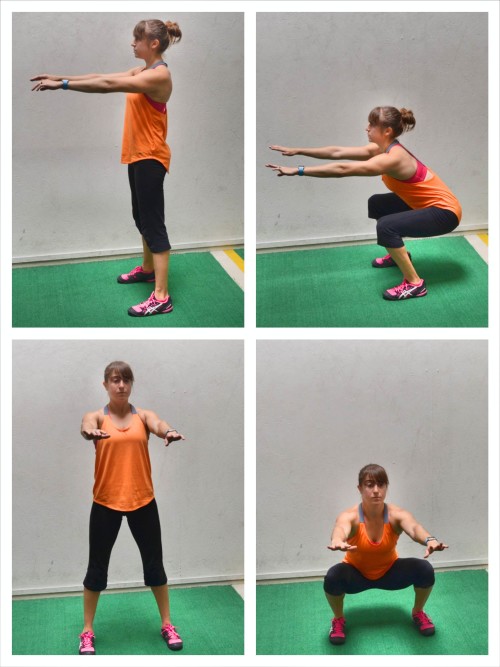
To do the Basic Bodyweight Squat, stand nice and tall with your feet about hip-width to shoulder-width apart. Your feet should be parallel and pointing straight ahead. You can place your hands across your chest on your shoulders or reach your hands out in front of you.
Then squat down, sitting your butt back and down as you. Bend your knees to sit back and squat as you keep your chest up. Keep your heels down as you drop your butt as close to the ground as you can.
Do not let your back round or chest fall forward as you squat. Also, make sure to keep your heels down. Only squat as low as your mobility allows.
Then come back up to standing, driving through your heels. Do not come forward onto your toes or lean forward as you stand back up. Squeeze your glutes at the top.
If your back rounds or if you shift your weight to one side or the other as you squat, do not squat as low and work on your mobility before increasing weight. You may also need to work on correctly imbalances if you shift your weight to one side or the other.
Also beware of your knees caving in or bowing out. Your hips, knees and ankles should all be in line as you squat.
If you find your squat depth is limited or your form has flaws, you will want to strengthen your glutes and improve your ankle, hip and even thoracic mobility.
You can add variety to this Basic Squat by using different weights, holding the weights in different spot, and even slightly changing up your stance and the tempo of your squat. You can also add some variety to the Basic Squat by combining it with other moves and by performing it in different planes of motion.
Squat Variations
Barbell Back Squat – The Barbell Back Squats is one of the most common Squats you see done in the gym. It allows you to go really heavy and challenge your legs because it doesn’t toast your core or your arms in the same way some of the other variations do. However, when doing the Barbell Back Squat, it is very important that you learn how to engage your back to keep the bar still and protect your shoulders. It is also important that you have good enough mobility that you don’t simply turn this move into a Good Morning.

To do a Barbell Back Squat, set up a bar on a Squat Rack or J-Hooks so that you can step under the bar and rest it on your back behind your shoulders. Do not rest it up on your neck, although the exact placement on the bar will depend on where it is comfortable. Make sure that when you grip the bar and rest it on your back that you engage your back, especially your lats to keep your shoulders safe.
Then step away from the rack with your back engaged. Set your feet between hip-width and shoulder-width apart. Without rounding forward, sit your butt back and squat down.
Sink as low as you can without your core giving out or without your knees buckling in. Make sure you sit straight back. Do not shift to one side. Also, make sure your heels stay down.
You may lean forward a bit as you squat, but do not turn this into a Good Morning. Keep your back flat.
Then drive back up to standing. Make sure you really drive through your heels and come straight back up. Do not go forward.
Squeeze your glutes at the top. Make sure to keep your core engaged the entire time.
Barbell Front Squat – Another great Barbell Squat variation is the Barbell Front Squat. This move is very core intensive and will work your back, abs and legs all at the same time. Beginners may want to start with a Dumbbell Front Squat or even a Goblet Squat Variation (with a dumbbell or kettlebell).

To do a Barbell Front Squat, set up a bar in a rack like you did for the Back Squat. Step forward so the bar is up at your shoulders, right at your collarbone. You can place your hands under it with your elbows up to support it or you can cross your arms and place your hands palms down on top to hold it in place. Just make sure it stays right up on top of your shoulders at your collarbone. This can require more wrist mobility especially if you don’t cross your arms. To improve your wrist mobility, check out these moves.
With the bar resting across the front of your shoulders and your chest up, squat down sitting your butt back. Do not round forward as you squat. Make sure to really keep your core tight and your chest up.
Drive through your heels to come back up to standing. Make sure you don’t go forward as you stand up.
Goblet Squat – A variation of the Front Squat can also be done with a kettlebell or dumbbell and is called the Goblet Squat. This Goblet Squat Variation challenges your legs and core, but also works your upper body as well.

To do the Goblet Squat with a kettlebell, take one kettlebell and turn it upside down, holding it on the bell. Set your feet between hip-width and shoulder-width apart.
Keeping the kettlebell in at your chest, draw your belly button in toward your spine and sit your butt back. Squat down and keep your chest up and don’t let your back round forward.
Sink your butt down as low as you can, keeping your heels on the ground. Try to touch your elbows to your knees, but not at the expense of really leaning forward or rounding over.
Then, driving through your heels, come back to standing. Do not lean or rock forward as you stand up. Come all the way up and squeeze your glutes at the top then sink back down.
Racked Kettlebell Squat – The Racked Kettlebell Squat is another variation of the Front Squat and is also a very challenging move for your upper body, core and legs. This is often harder for people than the Goblet Squat so make sure to start light.
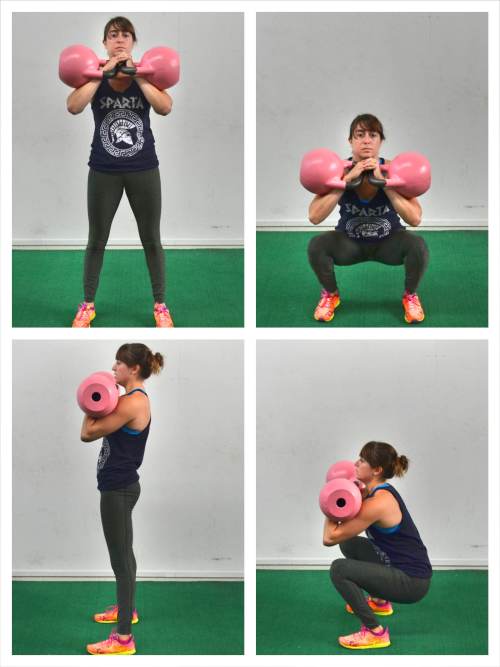
To perform a Racked Kettlebell Squat, place your hands through the handles of the kettlebells and let the weights rest on the back of your forearms. Bring your arms up and in toward your chest. Your hands and the kettlebells should be right against your chest with your elbows flaring out just a little. Press your chest out and do not shrug your shoulders as you hold the kettlebells up at your chest.
Your hands should be around the middle of your chest. Do not let your hands fall out toward your shoulders or your may put too much strain on the shoulders.
Keeping the kettlebell in that racked position, squat down, sitting your butt back and down. Make sure to keep your chest up and do not round forward. You should feel your upper back engage to help hold yourself upright.
Brace the core and squat as low as possible then drive back up to standing and squeeze your glutes at the top. Do not lean back at the top and load your low back. Then repeat.
Sandbag Front Squat – Another variation of the Front Squat that you can do with a Sandbag is the Sandbag Front Squat. The Sandbag is a great tool to use when squatting because it is an awkward, unstable weight that forces your core to have to work even harder.
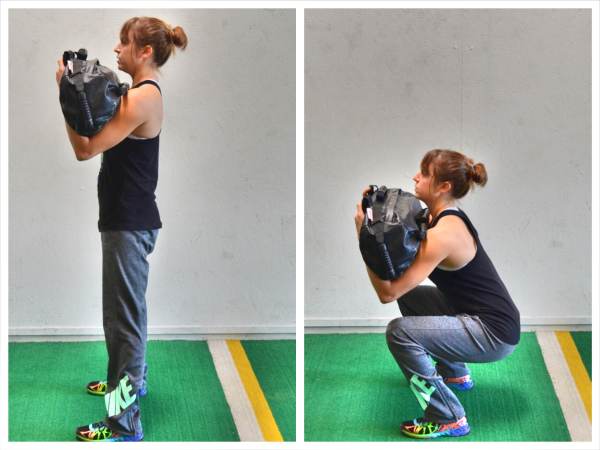
To do the Sandbag Front Squat, lift the sandbag and flip it up onto your upper arms so that you wrap your arms around it and hold hold it in close to your body at about chest/shoulder height.
Keeping your chest up, sit your butt back and down to squat as low as possible. Do not let the sandbag and your arms start to lower down. Keep the sandbag up high right at your chest.
Then drive through your heels to come back up to standing. Keep your core engaged to protect your low back and make sure to squeeze your glutes at the top. Like with all squats, make sure that you don’t round or go forward onto your toes.
Dumbbell Front Squat – You can also use dumbbells to do a Front Squat variation other than as a Goblet Squat.
This Dumbbell Front Squat is a great way to work your core and upper body and a great move to have in your repertoire since most traditional/hotel/home gyms have dumbbells even if they have nothing else!
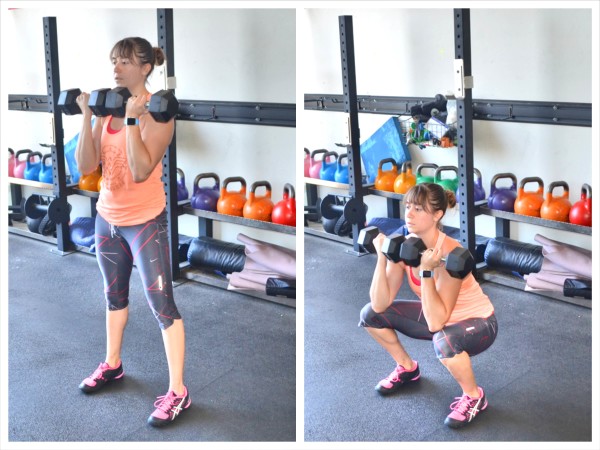
To do the Dumbbell Front Squat, hold a dumbbell in each hand. Bring the dumbbells up to the fronts of your shoulders with your palms facing back toward you.
Holding them up at your shoulders, sit your butt back and down while keeping your chest up. Make sure to sit back. Do not let your heels come up or your back round.
Squat as low as you can with good form and then stand back up and squeeze your glutes at the top.
Beginners can also hold one dumbbell up at their chest in both hands or even do the Goblet Squat unless they have a very light pair of dumbbells.
Bear Hug Squat – The Bear Hug Squat is a great squat variation to help you work through a bigger range of motion with proper form. It is also a great way to learn how to engage your core as you squat. This squat is even great for beginners because it helps you get lower in your squat and forces you to engage your core. It also allows you to use a heavy weight and really work your legs.
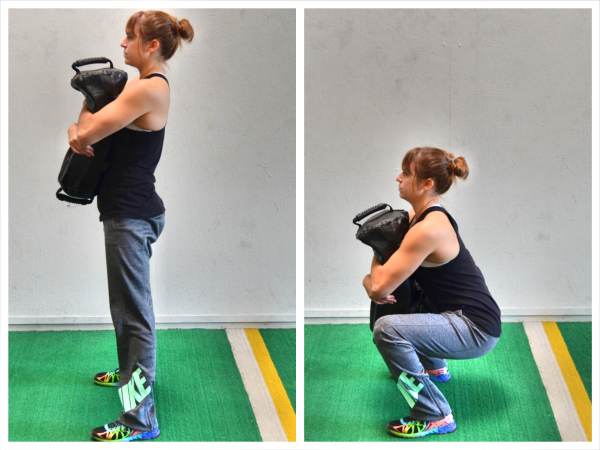
To do the Bear Hug Squat, turn the sandbag the long way and hug it into your chest, wrapping your arms around the middle of the bag. Your feet should be between hip-width and shoulder-width apart.
Keeping your chest up and the sandbag hugged in tight to your body, sit your butt back and down. Squat as low as you can. Sit back in your heels and don’t lean forward.
Do not let your back round forward as you sink down. Make sure your heels stay down as you sink as low as possible. Then drive straight back up, pushing through your heels.
Keep the sandbag in tight to your body. You may find that using a heavier weight actually helps you sink lower in the squat while keeping your chest up.
Landmine Squat to Press – By adding in a press to your squat, you can make the squat not only a great leg and core exercise, but also a great shoulder exercise. This is a great way to use that Front Squat and make it even a little more shoulder intensive.
However, if you really want to focus on strengthening your legs, you may find that you don’t want to include the press as the weight you use will be limited by what you can press overhead.
A great variation of the Squat to Press uses the Landmine.
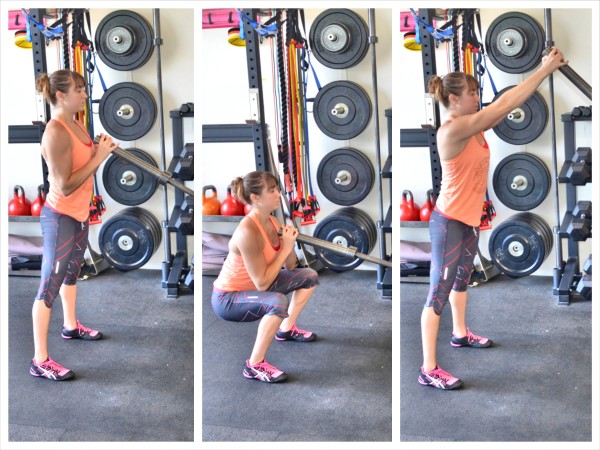
To do the Landmine Squat to Press, hold the barbell in both hands and face the Landmine. Bring the bar up to your shoulders and, holding it in both hands, squat down.
As you come back up to standing, press the barbell up and out. Extend your arms fully then bring the bar back down to your chest and squat back down.
If you press as you stand and use your legs, your arms will have some assistance. If you squat and then come to standing before you press, your arms will have to press the weight without the assistance of your legs.
Dumbbell Squat to Press – You can also do a Squat to Press using dumbbells. This is a great variation to not only challenge the shoulders but also the core. And because you are using dumbbells, you force each arm to work independently to press.

To do the Dumbbell Squat to Press, grab a dumbbell in each hand and bring the weights up to your shoulders. You can hold the weights with your palms facing forward or with your palms facing in toward each other.
Holding the weights at your shoulders, squat down sinking as low as you can. Then drive back up to standing and press the weights straight up overhead.
Make sure you don’t go forward as you squat down. Also make sure to press the weights straight up. Do not let your arms go out wide or all over the place.
The more you use your legs to press, the easier it should be on your upper body to press the weights. If you want to do a stricter press, squat then stand up and press once you are fully standing.
Overhead Squat – The Overhead Squat is a more advanced variation that requires a good amount of shoulder mobility as well as a lot of core strength. Do not attempt this variation if you haven’t mastered the basic weighted Squat.
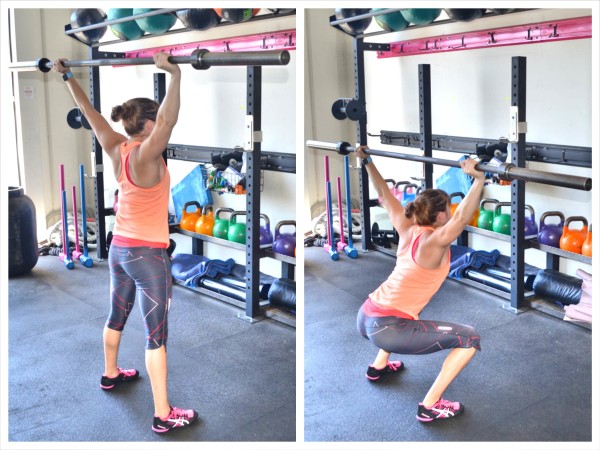
To do the Barbell Overhead Squat, grab the barbell in both hands and press it up overhead. Engage your lats to help stabilize the barbell overhead.
Then keeping the bar up overhead, sink down into the squat. Do not let the bar come forward as you squat down. Keep the core braced and your shoulders stable.
Come back up to standing and repeat. Do not let the barbell fall forward as you squat.
Sumo Squat – The Sumo Squat is a great way to work your adductors a bit more and can be done with just your bodyweight or with a kettlebell, barbell, sandbag or even dumbbells.

To do the Sumo Squat with a kettlebell, hold a kettlebell in both hands and set your feet wider than shoulder-width apart. Turn your toes out slightly as you stand in a wide stance with the kettlebell hanging down in front of you.
Squat down, sitting your butt down and back. Do not let your knees cave in as you squat. Drop the kettlebell to the ground but do not round forward.
Then drive back up to standing and squeeze your glutes at the top.
Narrow Stance Squat – Performing a Squat with a narrow stance can help you work your legs from a slightly different angle and puts a bit more emphasis on the quads. You can do this with just your bodyweight or by adding a weight once you’ve mastered the stance.
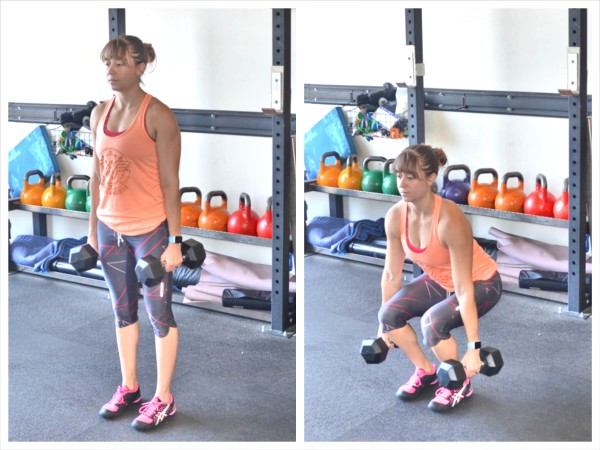
To do the Narrow Stance Squat, place your feet hip-width apart or closer. Squat down, sitting your butt back and down. Then drive back up to standing and squeeze your glutes.
Do not round forward or come forward onto your toes. Repeat, squatting as low as you can.
Staggered Stance Squat – The Staggered Stance Squat is a great way to start working toward a Single Leg Squat because it puts more emphasis on one leg. It is also a great Squat variation to help you work through a bigger range of motion if you Squat depth is limited by your ankle mobility.
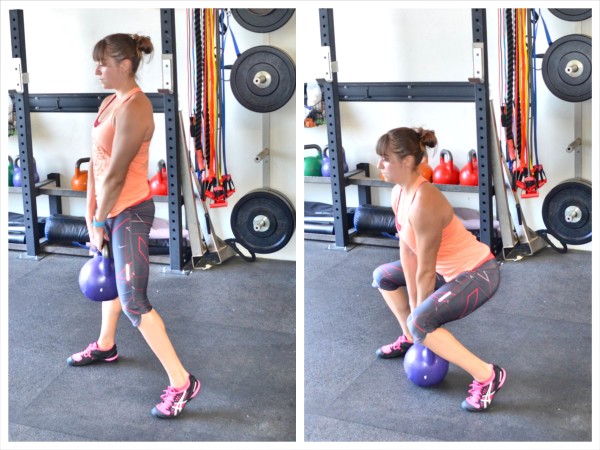
To do the Staggered Stance Squat, start with your feet between hip-width and shoulder-width apart. Then step one foot back so the toe is even with the heel of the front foot. Raise the heel of the back foot up off the ground.
Then sit back and squat down as low as you can. You can do this move holding a kettlebell in the Racked or Goblet position. Or you can hold the kettlebell down in front like with the Sumo Squat. You can even use a barbell, dumbbells or sandbag.
Just make sure your back heel stays up to put more emphasis on the working leg. Also, make sure that the front heel stays down. Do not go forward onto your toe.
Single Leg Squat Variations – To correct imbalances, you need to isolate each side and force it to work independently so that your stronger side can’t take over. That is why unilateral moves like the Single Leg Squat are important to include in your workout routine.
Even if you can’t do a full pistol squat, you can include the Single Leg Squat in your workout routine by either squatting to a bench or by using a Suspension Trainer like the TRX or Jungle Gym XT.
To do the Single Leg Squat to bench, choose a bench that is as low as possible. The lower the bench, the harder the move.

Stand in front of the bench and lift one leg out in front of you. Then sit back and squat to the bench. The more you completely sit and reset on the bench, the easier the move will be, especially if you lift your standing leg and then stomp it back into the ground.
If you just barely touch and go, you may find that the move is harder. Also, the more you swing your arms, the more momentum you will have to help you stand back up.
Make sure to keep the heel of the standing leg down as you squat and drive back up to standing.
Another great Single Leg Squat variation to do if you need a little assistance is the Suspension Trainer Single Leg Squat.
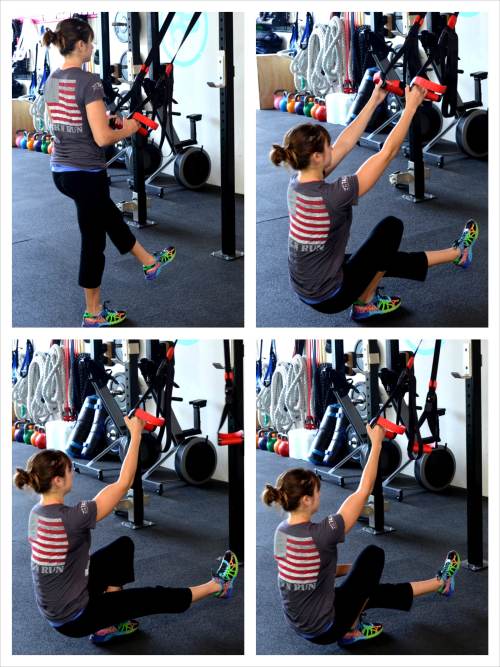
To do a Single Leg Squat, grab a suspension trainer strap in each hand and step back so there is a little tension in the straps. Then lift one leg out straight in front of you so you are balanced on one foot.
Sit your butt back and down to squat as low as you can while keeping your standing heel flat on the ground and your chest up. Then driving off the heel on the ground, stand back up.
Do not lean way forward or touch your raised foot to the ground to help you come back to standing. Only sit down as low as you can control and stand back up. If your heel starts to come off the ground, you don’t have the mobility to go that low or you need to focus on sitting back and down more.
The lower you go in the squat, the more advanced the move will be.
Also, to advance the Single Leg Squat, you can hold only one strap. Holding one strap in the opposite hand from the standing leg gives you a bit more balance than holding a strap in the same hand as the standing leg.
Complete all reps on one side before switching. Also, only use your arms as necessary. Do not turn this into an upper body exercise.
The straps are there for balance and slight assistance. If your arms are doing most of the work, you need to regress the movement and maybe not go as low.
Box Squats – A great way to improve your range of motion on the squat and how much weight you can use is the Box Squat. The Box Squat allows you to work on your squat technique so that you can lift more weight and really strengthen and tone your legs.
The Box Squat also forces you to pause at the bottom, which makes you have to work harder to stand back up. And because you can sit back more with the Box Squat, it is a great way to target your glutes and hamstrings more. (If you or clients also have problems getting your glutes to engage during Squats, this could be a good move to include in your workout routine!)
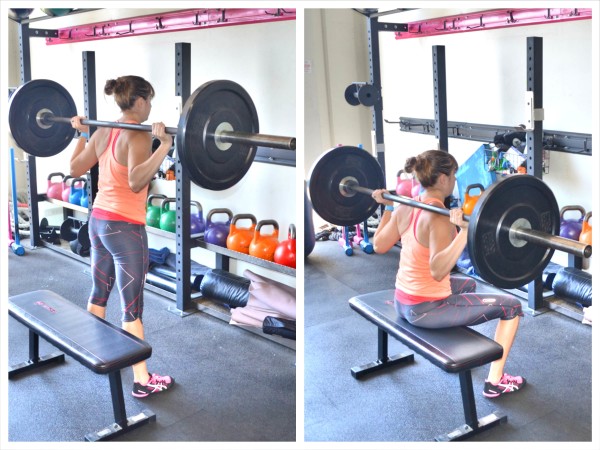
To do the Box Squat, place a box behind you at a height that allows you to maintain proper form, but is as low as possible. (Or if you are looking to up your max, you can place the box at either the bottom of your squat or at your stick point).
You can do the Box Squat with or without weights (in the video we show you the Box Squat as a Barbell Back Squat).
Then sit back and down to the box. Sit all the way down and pause for a second on the box before driving through your heels to come back up to standing.
Keep your chest up and really sit your butt back and down. Make sure that you don’t lean or rock way forward to stand back up.
Toe Squat – Generally when we Squat, we don’t want to come up onto our toes. It means our weight is going forward and we aren’t properly engaging our core, which won’t allows us to correctly work our legs (it can also lead to injury). However, if you set up on your toes to Squat, especially in the Sumo or Plie position, it can actually work your glutes even more. Plus it really works on your balance and your lower leg and ankle strength.
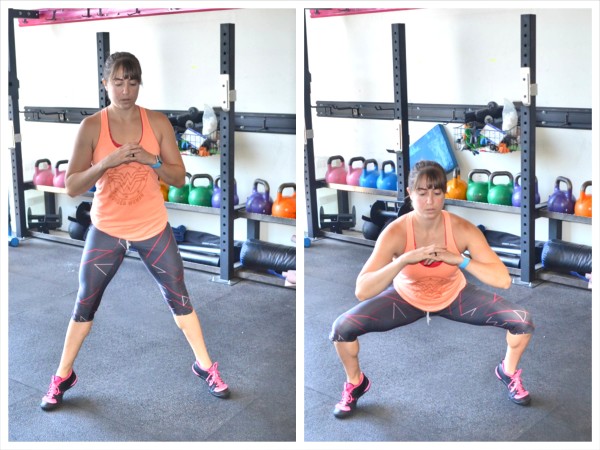
To do the Toe Squat, set up with your feet wider than shoulder-width and toes slightly turned out. Then press up as high as you can onto your toes.
Keeping your chest up and heels up off the ground, squat down as low as you can. Sit your butt down and back while staying balanced and then come back up to standing.
Try not to touch your heels down between reps.
Sink as low as you can and move in a slow and controlled fashion.
Squat Jacks – If you want to work your legs while getting your heart rate up, the Squat Jack is a great variation to include in your workout. This move combines the Jumping Jack with a Sumo Squat and even a Narrow Stance Squat (or Chair Pose). If you stay low throughout the movement, your lunges and legs should be burning!
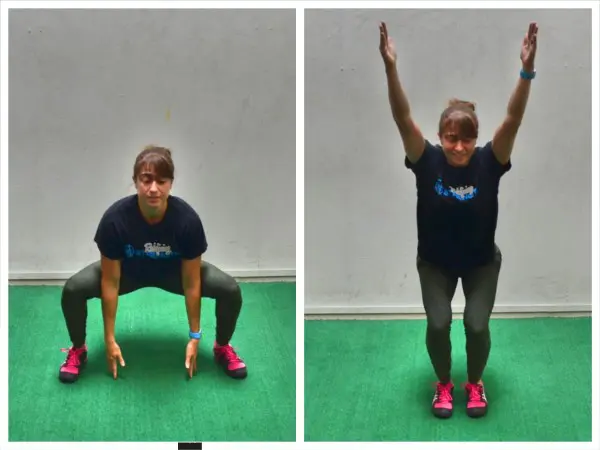
To do Squat Jacks, start standing with your feet together. Reach your hands up overhead and then sink into a little squat. Make sure to sit your butt back. This position should look like Chair Pose.
Staying low in the squat, jump your feet out wide, about shoulder-width apart. As you jump out, also bring your hands down and in between your legs to reach for the ground. Do not stand up out of the squat as you jump your feet out wide. Try to touch your hands to the ground as you keep your butt down in the squat and chest up. Even try to squat lower as you jump your feet out wide.
Then jump your feet back together and bring your hands back overhead.
Stay low in the squat the entire time and move quickly. Try not to stand up as you jump your feet back in. However, beginners may need to stand up as they bring their feet together and only squat as they jump their feet out.
Squat Pulses – While we often make Squats more difficult by adding weight, you can also make them harder by spending more time under tension. Squat Pulses are a great way to stay in the working range of a Squat for longer to make the move more challenging even without weight.
If you are doing any sort of timed workout, Squat Pulses are a great Bodyweight Squat variation to include.
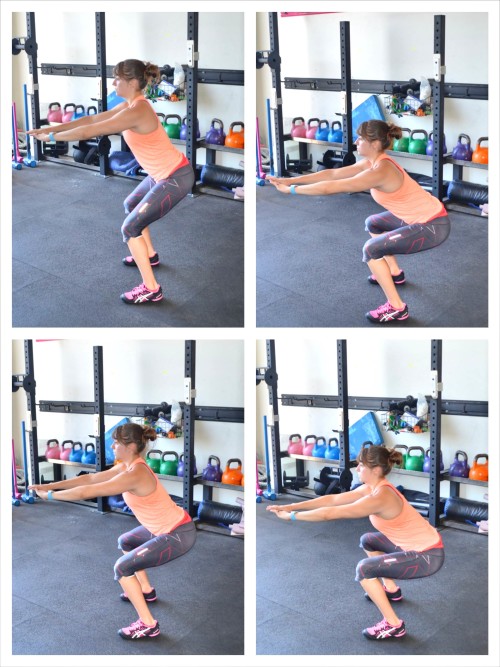
To do Squat Pulses, stand with your feet between hip-width and shoulder-width apart. Then sit your butt back and sink into a squat.
Pulse up and down, coming up toward the top of the squat and then sinking back down. Stay within that working range sometimes doing bigger movements and sometimes small pulses right around the bottom of the squat.
Squat Jump – Another great way to make Squats harder without weight is to make them explosive and speed up the tempo. Squat Jumps are a great way to develop great power and strength in your legs.
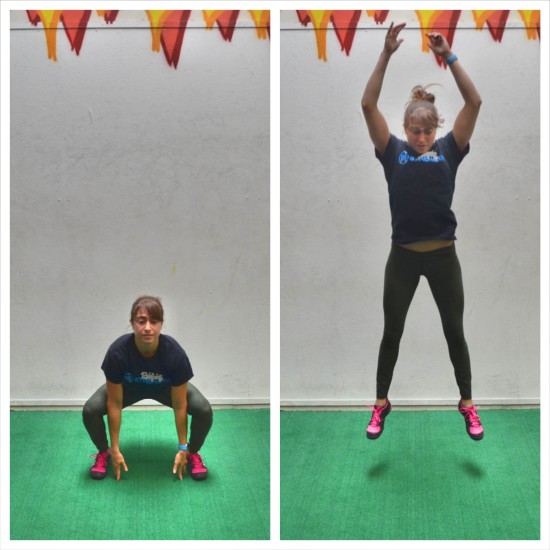
To do Squat Jumps, stand with your feet between hip-width and shoulder-width apart. Sit your butt down and back into as low a squat as you can with good form (aka your heels stay down and your chest stays up and your knees don’t cave in).
You can then swing your arms back as you squat or reach your hands down to touch the ground.
Then explode up out of the squat and jump as high off the ground as possible. You can swing your arms and reach your hands overhead to help propel you up. As you jump, extend your body fully.
As you land, sink right back into the squat so you can explode right back up. Do not land with your legs straight. Make sure to bend your knees as you land and try to land softly to protect your knees.
Beginners may need to rest between each rep; however, that doesn’t mean landing with your legs straight. You should never land with your legs completely locked. Bend your knees to help you absorb the impact of landing even if you pause between jumps.
Beginners can also start with a quick Basic Bodyweight Squat and even come up onto their toes as the stand up instead of completely leaving the ground. If they have good mechanics, they may want to leave the ground but not jump as high.
To make the move harder, jump up and sink right back into the squat to repeat as quickly as possible. Really focus on a soft landing and then exploding quickly into as high a jump as you can.
80/20 Squat Jumps – 80/20 Squat Jumps are a great way to mimic a unilateral move without having to actually balance on one leg. This Squat Jump variation forces one leg to do the majority of the work while the other leg really just helps you balance.
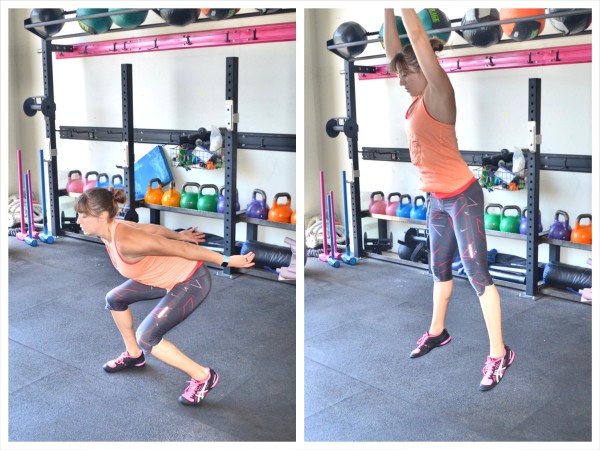
To do the 80/20 Squat Jumps, stand with your feet about hip-width to shoulder-width apart. Then move one foot back and raise the heel like you are doing the Staggered Stance Squats. You do not need your back foot to be even with the front heel. You can keep your feet a bit more even, but you want to shift your weight to one leg and only be on the ball of the other foot.
Squat down, sitting your butt back then jump up as high as you can. As you land, land back down on the front foot and ball of the back foot. Do not touch the heel of the back foot down.
Return right back into the squat and then repeat the jump. Complete all reps on one side before switching. You can use your arms to help propel you up by swinging them back as you squat and overhead as you jump.
Beginners will not want to jump as high and may only come up on their toes instead of leaving the ground.
Advanced exercisers will want to move more quickly and may even want to do a Single Leg Squat Jump.
Rotational Squat Jumps – Squats are generally a sagittal plane movement only so Rotational Squat Jumps are a great move to include because they make you work in more than one plane of motion. Plus they are a great way to make Squats more challenging without weights and get your heart rate up!
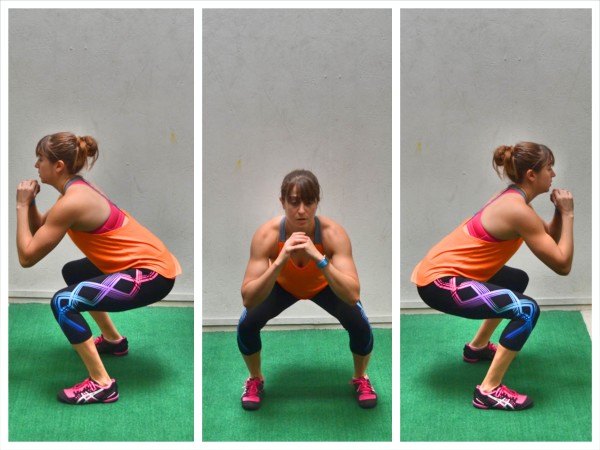
To do Rotational Squat Jumps, start facing forward with your feet about hip-width to shoulder-width apart. Squat down and then as you jump up, rotate to the right about 90 degrees.
As you land go right back into a squat to load for the next jump. Do not land with your legs straight even if you are a beginner. Sink into the squat and then jump back up and rotate back center.
When you land back center, squat down and jump 90 degrees to the left. Then load again and jump back to the center.
Make sure you don’t stay on your toes as you squat and that you sit your butt back to load your legs to help you jump higher. The faster you go and the higher you jump, the harder the move will be.
Wall Sit or Squat Hold – A great way to strengthen your quads, especially if you have had a previous knee injury, is the Wall Sit or Squat Hold. This is also a great way to work your quads and build mental toughness if you don’t have access to weights.
There is nothing more challenging mentally than having to hold a pose that is uncomfortable!
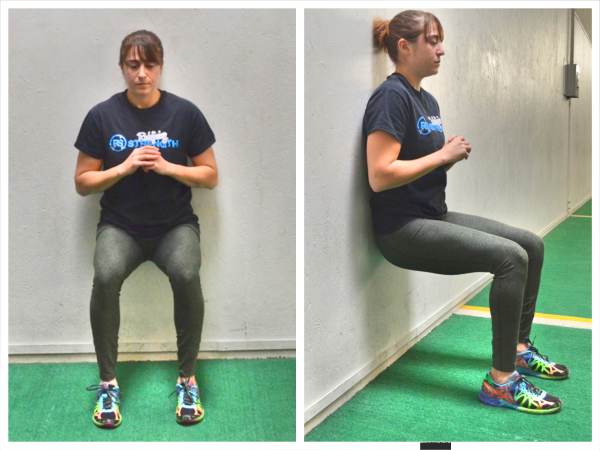
To do the Wall Sit, you will sit against the wall. Stand with your back to a wall and your feet about hip-width apart. Then sink down into a squat and press your back into the wall behind you.
When you sink into the squat, try to get your quads parallel to the ground and make sure your ankles are aligned under your knees. Hold there and drive your back into the wall.
You can also do this with a narrow or wide stance if you want to mix it up.
If you start to feel this in your low back, try engaging your core with a pelvic tilt. Press your low back toward the wall.
To make this move easier, don’t sink as low in the squat or move your feet out just a bit from the wall. Do not let your ankles get too far out in front of your knees though.
To make this move harder, hold a weight or even try a Single Leg Wall Sit.
If you don’t have a wall and want to do an Isometric Squat outside, you can simple do the Squat Hold.
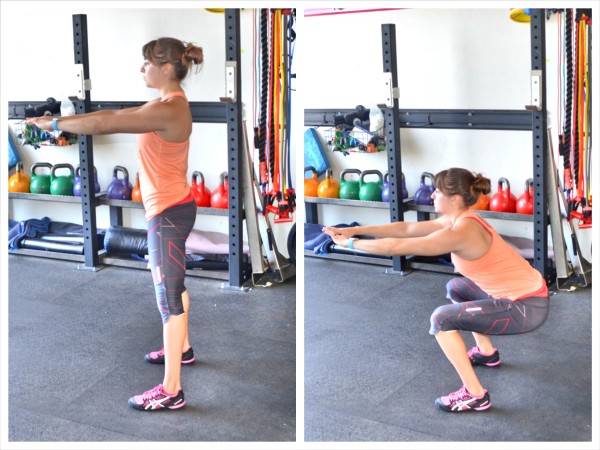
To do the Squat Hold, sit back into a squat and hold. Hold with your knees bent to about 90 degrees. Keep your chest up and your heels down as you hold.
Slow Eccentric Squat – Another great way to make Squats more challenging is by slowing down the tempo of the lower down or the push back up. If you slow down the lower down, it is a Slow Eccentric Squat. Slowing down the Eccentric portion of a lift can lead to more muscle tissue breakdown, which means your muscles have to grow stronger as they rebuild!
You can choose to load down this slow tempo Squat as long as you keep your pace slow. If you start to speed up the pace, lessen the weight.
It is best to do at least a 3-5 count Slow Eccentric Squat.
To do a 3 (or 5) Count Slow Eccentric Squat, start standing with your feet between hip-width and shoulder-width apart. Then slowly begin to squat down, counting to 3 or 5 before you hit the bottom of your squat.
Once you take 3-5 seconds to squat down, come back up to standing quickly. It doesn’t have to be explosive, but it should be a normal pace, a count of 1.
Repeat, taking 3-5 seconds to squat down.
Add weight if you can maintain the slow pace.
Pause Squats – Pausing at the bottom of the Squat is another way to mix up the tempo and make the Squat more challenging. It is also a great way to strengthen your legs to help you lift more weight and be able to stand up from the bottom of your Squat.
To do Pause Squats, you will set up with your feet between hip-width and shoulder-width apart. Squat down at a normal pace and pause and hold at the bottom of your squat. You can pause for 1 second or for 5.
Once you’ve paused at the bottom, drive back up to standing. Make sure to maintain proper form even with the pause at the bottom.
Do not come forward onto the balls of your feet as you squat or come back up to standing. Also keep your back flat and don’t round forward.
Add weight only if you can maintain proper form with the pause at the bottom. Don’t start to rush the move as you add weight.
Asymmetrical Weight or Unilateral Loads – While you can change up the Squat by using different weights, different stances and even different tempos, you can also force your core to work harder by loading down the move unevenly.
When you load your body down Asymmetrically (uneven weights on each side) or Unilaterally (with the weight on one side), you force your core to work even harder to stabilize and you can change the way that the Basic Squat works your body. Unilateral (one-sided) or Asymmetrical loading is a great way to correct imbalances and build more stability and strength in your core.
It is also a great way to make the squat even more functional since often you are lifting and squatting with uneven, awkward or even asymmetrical or unilateral loads in everyday life.
Below are some great Unilaterally-Loaded and Asymmetrically-Loaded Squat Variations. With the Unilaterally-Loaded moves, make sure to do reps with the weights on each side.
Unilateral Squat to Press with Landmine – With the Unilateral Squat to Press on the Landmine, not only do you force your core to work harder to fight rotation as you squat, but you also make each arm work independently to press.

To do the Unilateral Squat to Press with the Landmine, face the Landmine and hold the barbell in one hand at your shoulder with your feet between hip-width and shoulder-width apart.
Then squat down with the barbell at your shoulder. Sit your butt back and down. Do not round forward or come up onto your toes.
Come back up to standing and press your arm with the barbell up overhead. Bring the weight back down to your shoulder and repeat the squat.
To use your legs more to help you press, press as you stand up out of the squat. To force your arm to work more, squat then press once you’ve returned to standing.
Complete all reps on one arm before switching.
Single Racked Kettlebell Squat – Another great Unilaterally-Loaded Squat is the Single Racked Kettlebell Squat. With this move you will rack only one kettlebell on one side.
Make sure that as you squat, you do not lean or rotate. This is a great move to develop anti-rotational core strength and stability, which will help you prevent injuries.
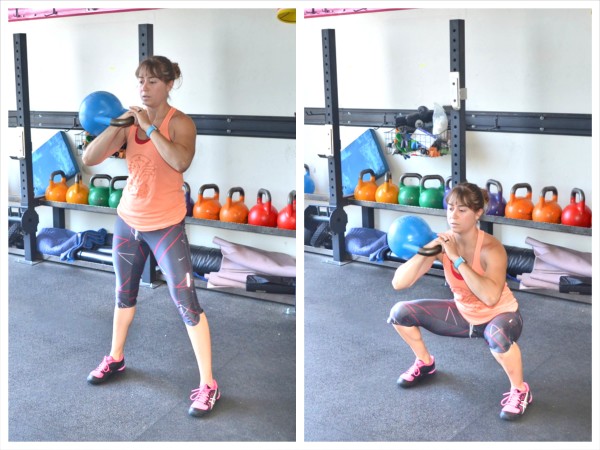
To do the Single Racked Kettlebell Squat, rack only one kettlebell on one side. To rack the kettlebell, place your hand through the handle and rest the kettlebell on the back of your forearm. Bring your hand into the middle of your chest and let your elbow flare out to the side just a bit.
Do not let your hand fall out toward your shoulder.
Then, as if you had weights on both sides, squat down. Do not lean or shift or rotate as you squat. It should look like you don’t have a weight on one side or at least have even weights on both sides.
Sit your butt back and squat as low as you can. Then come back up to standing. Make sure to use proper squat form even when squatting with a Unilateral load.
Shouldered Sandbag Squat – The Shouldered Sandbag Squat is another great Unilaterally-Loaded variation and very similar to the Single Racked Kettlebell Squat except that the sandbag is over your shoulder.

To do the Shouldered Sandbag Squat, place a sandbag over one shoulder and stand with your feet between hip-width and shoulder-width apart. Squat down.
Just like with the Single Racked Kettlebell Squat, do not shift or rotate or lean. Your squat form should look just like the Basic Bodyweight Squat.
Asymmetrically-Weighted Squat – With all the Unilaterally-Loaded Squats, you only have weight on one side. With the Asymmetrically-Weighted Squat, you have a weight on both sides, however, the weights are different. One weight will be heavier than the other and will want to pull you toward that side.
Like with the Unilateral Load, you need to fight the rotation, lean or shift.
A great Asymmetrically-Weighted Squat uses kettlebells.

To do the Asymmetrically-Weighted Kettlebell Squat, rack two kettlebells of different weights at your chest like you would for the Racked Kettlebell Squat.
Then squat down maintaining perfect squat form. Sink as low as you can without rounding forward or letting your knees cave in. Make sure to keep your heels down.
Do not shift or rotate with the uneven weight. It should look like the weights are exactly the same.
Come back up to standing and repeat. Make sure to switch the weights and have the heavy weight on each side.
Using these 30 Squat Variations you can work your legs from different angles and even get in a great core workout! Plus you can correct imbalances to move better, lift more and even prevent injuries.
Which are your favorite Squat Variations?

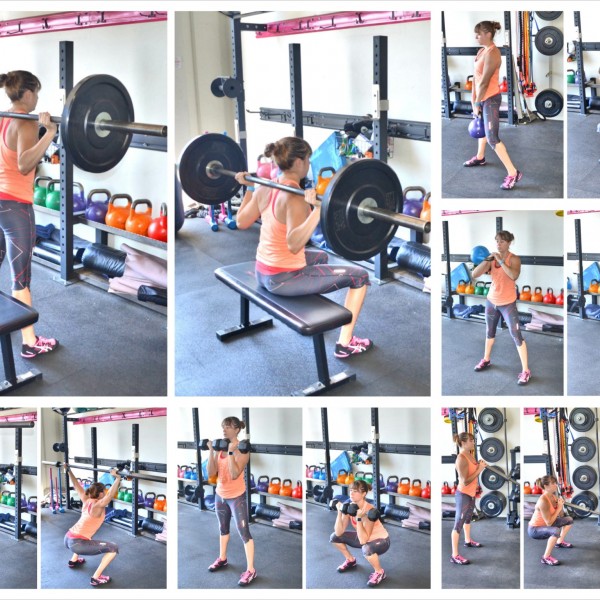


Hi, apart from the wall squat, what would you recommend for strengthening legs when you have a dodgy knee?
Thanks
Bec
Hi Bec! Here are actually 22 moves I use with clients: https://www.youtube.com/watch?v=yeLQwNgU_Qo
Also, these booty burners are great as you want to activate your glutes – https://redefiningstrength.com/5-quick-booty-burners-to-build-a-better-butt/
If you need anything else, let me know! – Cori
Thanks Cori, that’s really helpful. I particularly find the quads hard to develop without squats and lunges and as a cyclist I’d love to get them stronger
No problem! If you have any questions when starting to use the moves, don’t hesitate to email me at [email protected].